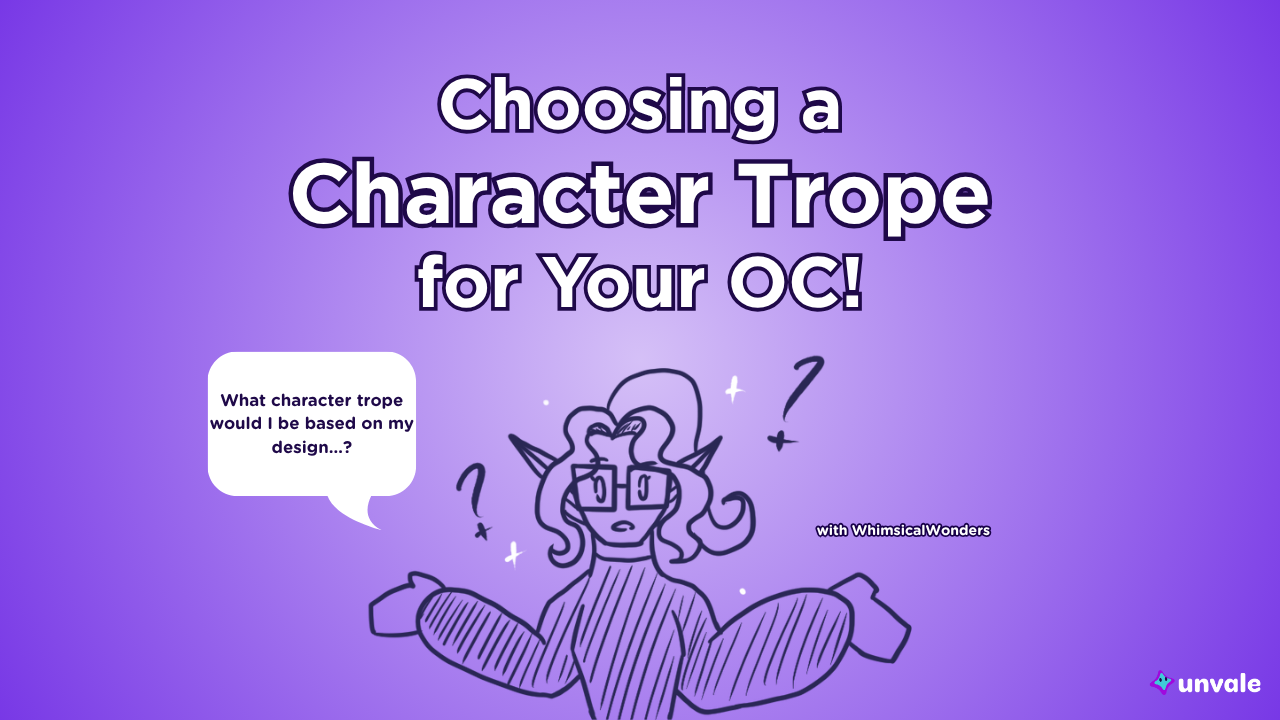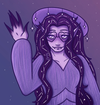Choosing a Character Trope For Your OC!

Ever design a character…before you came up with their personality, or what kind of character they were? Maybe you were stuck…and you didn’t know what to do! Well, you can try using character tropes based on your OC’s design! How? Let’s talk about it!
If you’re looking for more ways to develop your OCs, you can try giving them a role, companion, or powers!
What’s a character trope?
First off, let’s quickly talk about what a character trope is! A character trope is a common concept you see in media. They can make you familiar with a character before you know much else about them!
A character trope gives you an idea about a character’s personality, or their role in the story! You’ve definitely seen them before. These are your anti-heroes, jocks, nerds, mentors…and many more!
Some character tropes can be fairly specific, and some can be more broad. If you’ve seen different kinds of them in different stories, they’re likely a character trope! There’s lots of character tropes out there, and not all characters of the same trope will be exactly alike.
What’s your OC’s shape language?
One thing you can consider is the shape language of your OC! The shape language of your OC can say a lot about them, and you can use it to decide what tropes might fit your character better! If you’re not too sure what exactly shape language is, you can check out this article here!
Shape language can help you narrow down the kind of tropes you can use for your OC! Maybe a character with lots of triangles or sharp edges in their design could be your easily angered hot-headed trope, or your cold and mysterious loner trope! On the other hand, an OC with lots of curves or circles in their design could be the lovable and goofy sidekick, or the silly and fun comic relief character! Here’s some ideas for shape language and the tropes they might match:
- Circle shape language for clown characters, parental characters, cowardly characters, hero characters, or princess characters.
- Square shape language for mentor characters, nerdy characters, stoic characters, grumpy characters, or protective characters.
- Triangle shape language for villain characters, antihero characters, bully characters, rebel characters, or bad boy characters.
The overall shape language of your OC can be a great way to get started with the kind of character trope you want your OC to be! If your OC has multiple types of shape language, your OC could have more than one character trope too! Maybe an OC with square and circle shape language is both the protective trope and parental trope, or an OC with triangle and circle shape language is both the rebellious trope and the princess trope!
You can also choose a trope that doesn’t quite fit your character’s shape language! Maybe you’ll choose to trick your audience by making the OC with circle shape language the antihero of the story, or maybe the OC with square shape language is actually the coward of the hero team! It’s all up to what you want to do for your story, and what you think will fit your OC’s best!
A good example of using shape language for character tropes would be Artgelic’s OC The Commander! The Commander is a villain trope with lots of sharp shape language!
Another good example for using shape language and character tropes would be Rongrii’s OC James! James is also a villain who also has lots of triangle shape language!
What’s your OC’s aesthetic and style?
Another thing you can consider when thinking about what trope you can make your character is your OC’s aesthetic! The style your OC has can match their character trope. Different aesthetics have a different feel to them, and different tropes might work well with it better than other options!
You’ll want to think of what kind of aesthetic your OC has, and what your audience might think about them based on that! While not always, sometimes certain aesthetics can give off a different impression than others. Some clothing choices might make you think of different character tropes as well. A varsity jacket might bring to mind the jock trope, while a pair of glasses might make you think of the nerdy trope. Using what you already have as part of their design can help you choose what they could be! Here’s some ideas to get your creativity flowing:
- A villain trope who has a dark aesthetic
- A comic relief trope who has a wild outfit style
- A sassy trope who has a preppy aesthetic
- A suave trope who has a put-together outfit style
The aesthetic and style of your OC can be an easy way to help you choose a character trope for them! If your OC has a specific style or aesthetic, you can look at different character tropes to see what might fit them best! You can even look at your favorite tropes across your favorite stories, and see what all they have in common! What parts of their outfits do they share? Do they have a specific style to them? Can you tell what trope they are just by looking at their outfit?
Maybe you’ll choose a trope that doesn’t seem to fit your OC’s aesthetic on purpose! Looks can be deceiving, and that can apply to characters too! An OC might have a certain style or aesthetic, and be a character trope that the audience wouldn’t expect. Depending on what your story is and who your character is, doing something different might work better than choosing a trope that matches the character’s aesthetic!
A good example of using style for a character trope would be Deathssons’ OC Fredrick! Frederick is a jock character trope, and he has a jacket that matches well with that!
Another good example of using style for a character trope would be GMSoters’ OC Snippet! Snippet is a villain trope with a fancy red suit that matches his character well!
What’s your OC’s motif?
Another way you could go about picking a character trope is the motif your OC has, if they have one! Certain elements might make you think of certain character tropes, like a specific symbol! You can use this to your advantage for your characters, as your audience might get an idea about them based on the motif they have!
Thinking about motifs and what they might say about your OC can be a great way to come up with the trope they might be! Symbols like skulls, moons, and bats might make you think of common villain tropes! (That being said…I’m not a villain! Trust me!) Other symbols such as flowers, the sun, or stars might make you think of heroes or supporting characters tropes. Here’s some ideas to help you brainstorm:
- A villain trope with a skull motif
- A hero trope with a sun motif
- A inventor trope with an electric motif
- A mystical being trope with a star motif
There’s lots of options to choose from when it comes to motifs, and choosing a trope based on the theme your OC has can be a great way to tell the audience what kind of character your OC is! Different motifs can have a different feel to them, and you can use that to choose what you’ll do!
You could even be misleading, and pick a trope that the audience wouldn’t expect from the character’s motif! Maybe the villain has a sun motif, and the hero has a moon one! It all depends on your story and what you want to do with it!
What’s your OC’s hairstyle?
Similar to aesthetics and motifs, one more thing you can think about your OC’s design when choosing a character trope for them is the hairstyle they wear! The hairstyle an OC wears can match the trope they might have! Even though it might seem simple, the hairdo a character has can tell the audience more than you’d think!
The way a character wears their hair can say a lot about them, and can give off a certain impression! You can use that to help you narrow down the character tropes they might have, and go from there! Here’s some ideas for hairstyle and tropes to get your creativity flowing:
- A mad scientist trope with wild, spiky hair
- A wise older character trope with long grey hair
- A teacher trope with a bun or ponytail
- An elegant royal trope with a fancy hairdo
There’s lots of different hairstyles that could show off different tropes! Sometimes, just a quick glance at a character’s hairstyle can give you an idea as to what kind of trope they are! Using this as a way to help choose your OC’s trope can be quick and easy!
You could even do the opposite as well! Maybe a character expected to be one trope because of their hairstyle is actually a completely different trope altogether! Have you ever seen a character in media who is set up as if they’re a certain trope, but the actual trope walks in soon after? You could do something like that as well! There’s plenty of options to choose from, and it’s all up to you!
A good example of using hairstyle for choosing a character trope would be Bread’s OC Sofia! Sofia is a popstar singer trope with a fun and extravagant updo to match!
Another good example of using hairstyle for a character trope would be Solinkie’s OC Misha! Misha is a cold mistrusting trope who has a half-shaved hairstyle that goes well with that!
There’s lots of ways you can go about choosing a character trope for your OC based on their design! Thinking about your OC’s shape language, aesthetics, motifs, and hairstyles can all be a part of how you choose your character’s trope! It’s all up to you, and remember to have fun with it!

